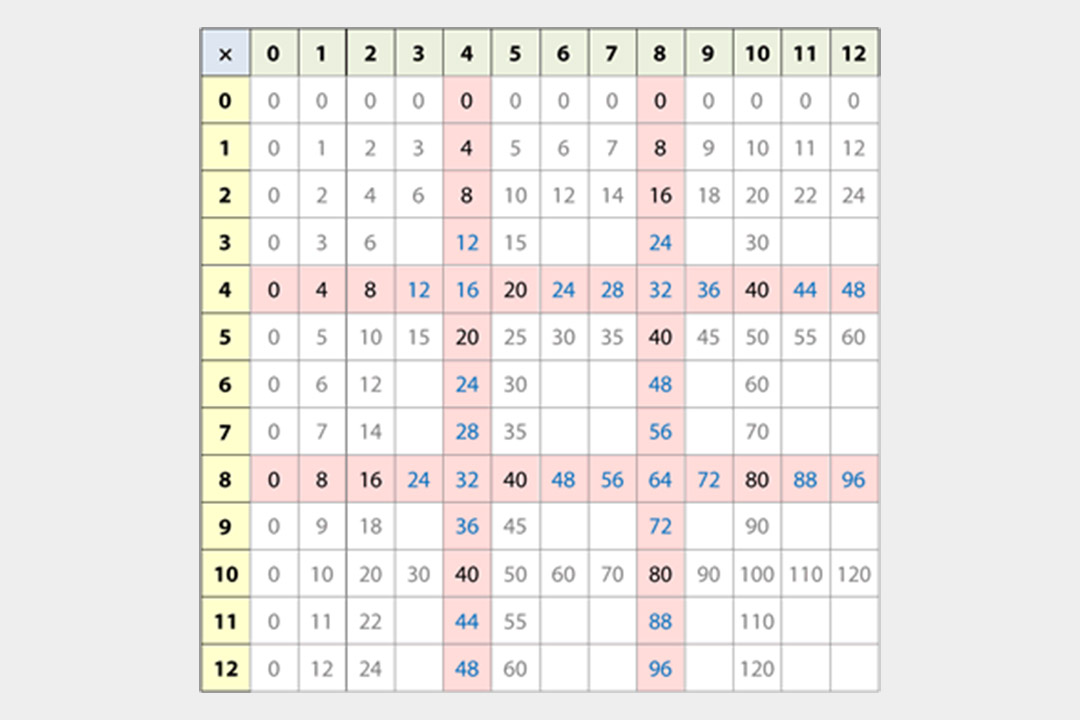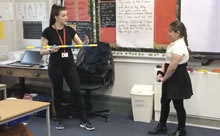Six resources for teaching and learning times tables
How do your pupils learn times tables? From digestible research to interesting resources, these ideas will help you reflect
10/03/2020

Class multiplication chart from the NCETM Mastery Professional Development Materials Multiplication and Division 2.7 Teacher guide.
You probably don’t need reminding that the times tables test is coming to Year 4 in June 2020. Officially, it’s called the Multiplication tables check (MTC) and it can be done any time within a three-week window from 8 June. Inevitably, it’s likely to make teachers and schools reflect on how they teach times tables.
The National Curriculum states that fluency and conceptual understanding should be developed in tandem because each supports the development of the other. So, how can we teach times tables for secure conceptual development as well as fluency?
Teachers on a recent Twitter chat (#mathscpdchat) seemed to agree that using a variety of methods, games and representations was key. Below, we offer a summary of the chat, have picked out some of the suggestions we liked best and added a couple of links to relevant research.

Our weekly CPD discussion on Twitter is open to all teachers of maths*. The summary of a recent discussion on Strategies to help pupils learn (and securely retain) times tables facts allows you to catch up on the conversations and follow up any threads that interest you. It includes a list of resources and ideas recommended by participants. Some of these are commercial sites but many of them have resources available for free. While you might have expected engagement from primary teachers, there were teachers from all phases, including post-16.

In a short video clip tweeted by Primary Mastery Specialist, Nicol Winfield, her pupil uses knowledge of how tables facts relate to one another (e.g. doubling 2×7 to give 4×7) to help remember the 7 times table. Nicole’s technique is based on Jill Mansergh’s video Tables with a Number Stick, where she shows how the 17 times table can be learned in less than ten minutes.

For anyone wanting a singing approach to ‘chanting’, teacher Martyn Yeo has helpfully made a YouTube playlist putting sing-along videos in one place.

Spine 2: Multiplication and Division of our Primary Mastery Materials provides comprehensive guidance and support for conceptual understanding of the times tables and relationships between them. Multiplication and Division is presented in 30 segments, six of which focus specifically on times tables (see 2.3, 2.4, 2.7, 2.8, 2.9 and 2.11 in Years 2, 3 and 4). Each includes a detailed teacher professional development guide with images helpful to conceptual understanding. The images are also provided on PowerPoint slides that can be used in the classroom.

A whole school intervention for teaching, learning and understanding times tables by Professor Jenny Field (published in the Spring 2020 edition of Primary Mathematics), describes the research she has done, in collaboration with London South East Maths Hub, in supporting schools to structure their own research-based curriculum for times tables. It includes ‘Eight Steps’ to help build a whole-school approach including suggestions for how much, how often, the order in which the tables should be taught, consistency of presentation and language, exploring patterns and links to the real world.

Espresso is ‘a small but intense draught of filtered research on mathematics education, expressly designed with teachers in mind’ from Cambridge Maths. In 2016, Espresso covered Learning and Assessing Times Tables with some easily-digestible findings.
* Our Twitter-based chats, using the hashtag #mathscpdchat, with a different host each week, happen every Tuesday at 7pm and cover maths teaching across all age ranges. The chats are loosely organised by the NCETM and summarised on a dedicated page on our website, so you don’t need to be a social media user to benefit.
Image credits
Numberblocks © Alphablocks Ltd, all rights reserved
Times tables graph from Espresso used with permission